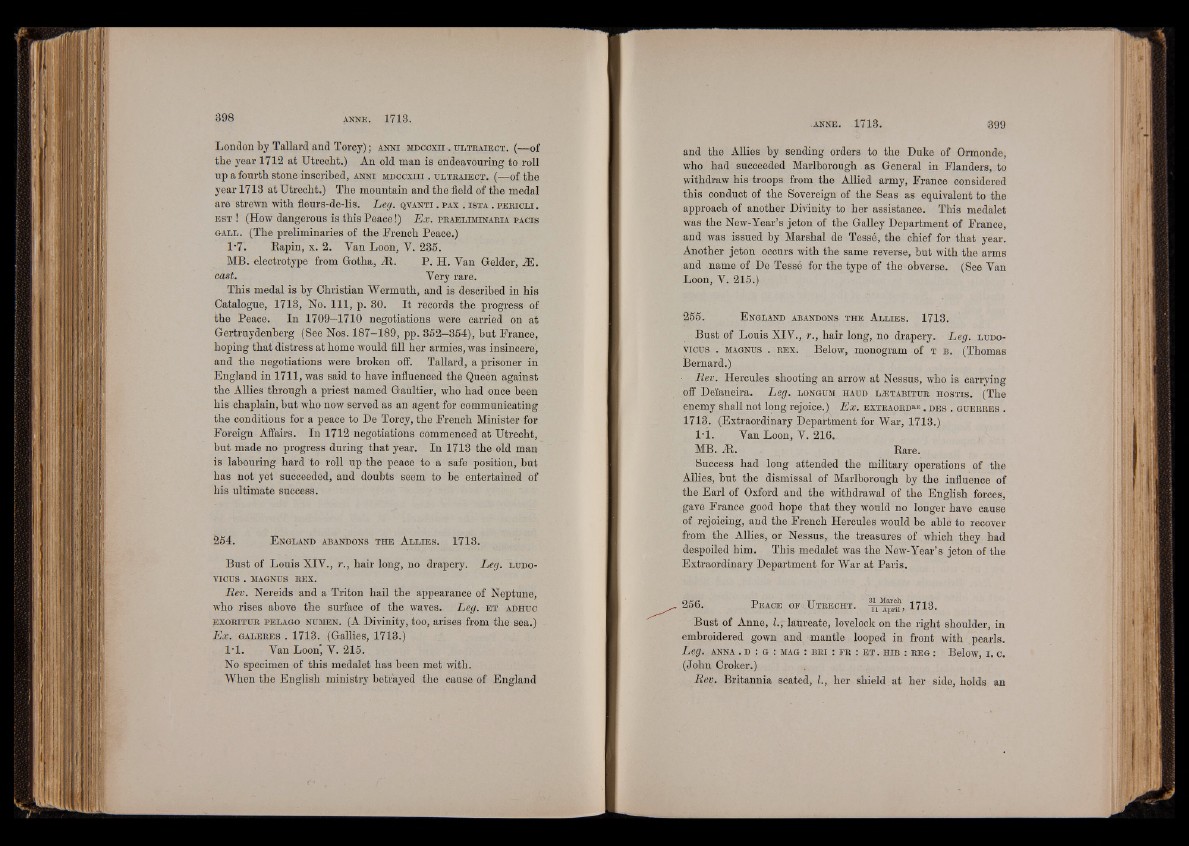
London by Tallard and Torcy); a n n i m d c c x i i . u l t b a ie c t . (—of
the year 1712 at Utrecht.) An old man is endeavouring to roll
up a fourth stone inscribed, a n n i m d c c x h i . u l t b a ie c t . (—of the
year 1713 at Utrecht.) The mountain and the field of the medal
are strewn with fleurs-de-lis. Leg. qvanti . pax . is t a . p e e ic l i .
e s t ! (How dangerous is this Peace!) Ex. p e a e l im in a b ia pa c is
g a l l . (The preliminaries of the French Peace.)
1'7. Rapin, x. 2. Van Loon, V. 235.
MB. electrotype from Gotha, At. P. H. Van Gelder, M.
cast. Very rare.
This medal is by Christian Wermuth, and is described in his
Catalogue, 1713, No. I l l , p. 30. It records the progress of
the Peace. In 1709—1710 negotiations were carried on at
Gertruvdenberg (See Nos. 187-189, pp. 352—354), but France,
hoping that distress at home would fill her armies, was insincere,
and the negotiations were broken off. Tallard, a prisoner in
England in 1711, was said to have influenced the Queen against
the Allies through a priest named Gaultier, who had once been
his chaplain, but who now served as an agent for communicating
the conditions for a peace to De Torcy, the French Minister for
Foreign Affairs. In 1712 negotiations commenced at Utrecht,
but made no progress during that year. In 1713 the old man
is labouring hard to roll up the peace to a safe position, but
has not yet succeeded, and doubts seem to be entertained of
his ultimate success.
254. E n gland abandons t h e A l l i e s . 1713.
Bust of Louis XIY., r . , h a i r long, no d r a p e r y . Leg. l u d o -
VICUS . MAGNUS BEX.
Rev. Nereids and a Triton hail the appearance of Neptune,
who rises above the surface of the waves. Leg. e t adhuo
e x o b it u e p e l a g o n u m e n . (A Divinity, too, arises from the sea.)
Ex. g a l e e e s . 1713. (Gallies, 1713.)
l ' l . Yan Loon", Y. 215.
No specimen of this medalet has been met with.
When the English ministry betrayed the cause of England
and the Allies by sending orders to the Duke of Ormonde,
who had succeeded Marlborough as General in Flanders, to
withdraw his troops from the Allied army, France considered
this conduct of the Sovereign of the Seas as equivalent to the
approach of another Divinity to her assistance. This medalet
was the New-Year’s jeton of the Galley Department of France,
and was issued by Marshal de Tessè, the chief for that year.
Another jeton occurs with the same reverse, but with the arms
and name of De Tessè for the type of the obverse. (See Van
Loon, Y. 215.)
255. E ngland abandons t h e A l l ie s . 1713.
Bust of Louis XIV., r., hair long, no drapery. Leg. lu d o -
v ic u s . MAGNUS . Be x . Below, monogram of t b . (Thomas
Bernard.)
Rev. Hercules shooting an arrow at Nessus, who is carrying
off Deianeira. Leg. longum h a u d l e t a b it u e h o s t i s . (The
enemy shall not long rejoice.) Ex. ex t ba o b d »e . d e s . g u e e e e s .
1713. (Extraordinary Department for War, 1713.)
l ' l . Van Loon, Y. 216.
MB. Ai. Rare.
Success had long attended the military operations of the
Allies, but the dismissal of Marlborough by the influence of
the Earl of Oxford and the withdrawal of the English forces,
gave France good hope that they would no longer have cause
of rejoicing, and the French Hercules would be able to recover
from the Allies, or Nessus, the treasures of which they had
despoiled him. This medalet was the New-Year’s jeton of the
Extraordinary Department for War at Paris.
256. P ea c e o f U t b e c h t . 1713.
Bust of Anne, L; laureate, lovelock on the right shoulder, in
embroidered gown and mantle looped in front with pearls.
Leg. anna . d : g : mag : b e i : f e : e t . h ib : e e g : Below, i. c.
(John Croker.)
Rev. Britannia seated, I., her shield at her side, holds an